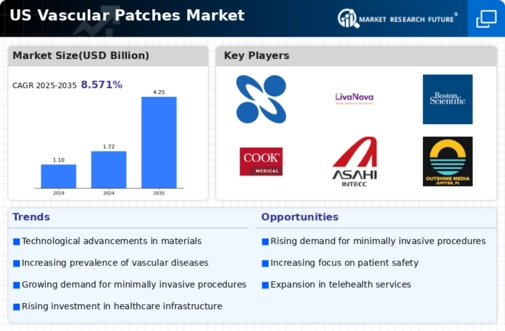Advancements in Biomaterials
Innovations in biomaterials are significantly influencing the vascular patches market. The development of biocompatible and bioresorbable materials enhances the performance of vascular patches, making them more effective in surgical applications. For instance, patches made from synthetic polymers or collagen are gaining traction due to their favorable properties, such as reduced risk of infection and improved healing times. The market is witnessing a shift towards these advanced materials, which are designed to mimic natural tissue properties. This trend is supported by research indicating that the use of advanced biomaterials can lead to better patient outcomes. Consequently, the vascular patches market is likely to benefit from these technological advancements, as healthcare providers increasingly adopt innovative materials for vascular repair.
Surge in Surgical Procedures
The surge in surgical procedures related to vascular interventions is a crucial driver for the vascular patches market. As more patients undergo surgeries such as bypass grafting and aneurysm repairs, the need for reliable vascular patches increases. Data indicates that the number of vascular surgeries performed annually in the US is on the rise, with estimates suggesting a growth rate of around 5% per year. This trend is likely to continue as the population ages and the prevalence of vascular diseases escalates. Consequently, the vascular patches market is positioned to expand, driven by the increasing volume of surgical procedures that require effective patching solutions to ensure successful outcomes.
Growing Awareness and Education
Growing awareness and education regarding vascular health are driving the vascular patches market. As healthcare professionals and patients become more informed about vascular diseases and their treatment options, there is a heightened demand for effective surgical solutions. Educational initiatives and campaigns aimed at promoting vascular health are contributing to this trend, leading to increased screening and early intervention. This proactive approach is likely to result in more patients seeking surgical treatments, thereby boosting the demand for vascular patches. The vascular patches market is expected to benefit from this increased awareness, as healthcare providers respond to the rising need for effective materials in vascular surgeries.
Increased Healthcare Expenditure
The rise in healthcare expenditure in the US is a significant driver for the vascular patches market. With healthcare spending projected to reach approximately $6 trillion by 2027, there is a growing investment in advanced medical technologies, including vascular patches. This increase in funding allows for the development and adoption of innovative surgical solutions, which are essential for treating vascular conditions. Additionally, as hospitals and surgical centers allocate more resources towards improving patient care, the demand for high-quality vascular patches is expected to rise. The vascular patches market stands to gain from this trend, as healthcare providers seek to enhance surgical outcomes and patient satisfaction through the use of superior materials and technologies.
Rising Incidence of Vascular Diseases
The increasing prevalence of vascular diseases in the US is a primary driver for the vascular patches market. Conditions such as peripheral artery disease (PAD) and aortic aneurysms are becoming more common, leading to a higher demand for effective treatment options. According to recent statistics, approximately 8.5 million adults in the US are affected by PAD, which necessitates surgical interventions where vascular patches are utilized. This growing patient population is likely to propel the market forward, as healthcare providers seek innovative solutions to address these conditions. Furthermore, the aging population, which is more susceptible to vascular issues, is expected to contribute to the market's expansion. As a result, the vascular patches market is poised for growth, driven by the urgent need for effective surgical materials to treat vascular diseases.

















Leave a Comment